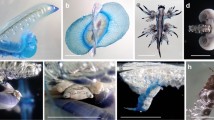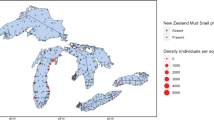Abstract
During the Italian Antarctic Expedition of 1987–1988 zooplankton was collected in Terra Nova Bay (Ross Sea) by a multinet BIONESS (250-μm or 500-μm net mesh size). The early life history of Pleuragramma antarcticum was described from 268 samples. More than 98% of a total of 34,436 fish larvae belonged to P. antarcticum. The mean relative abundance in the whole area for positive 0 to 150-m hauls was 434 ind./100 m3 (±720 SD). Postlarvae were most abundant and frequent in the samples (99.8%) while low concentrations of juveniles were found (n=67). Length of age group 0 ranged from 8 to 20 mm and age group 1+ were from 36 to 53 mm. Average growth rate over a period of 1 year was 0.08 mm per day. Based on modal values, the mean daily increment of P. antarcticum postlarvae in the period 5 January to 2 February (29 days) was about 0.21 mm. Highest abundances occurred near Cape Washington (mean: 2,108 ind./100 m3) while lower densities were recorded in the northern basin of the self (31 ind./100 m3). Horizontal and vertical distribution patterns in Terra Nova Bay seem to be strictly correlated to hydrographic features and different water masses with highest densities associated with the westward flowing current of the limb of the Antarctic coastal current and southern limb of the Ross Sea Gyre. These currents become part of the clockwise gyre in Terra Nova Bay. More than 62% of the postlarvae were collected in well-stratified warm surface water (0–50 m) near the summertime thermocline (20–70 m). The northern part of Terra Nova Bay seems to represent nursery ground of early stages of P. antarcticum and the presence of permanent polynya could provide favourable food conditions for development of the first stages of life. Differing distribution patterns probably reflect an interaction of various parameters including bathymetry, floating ice shelf, hydrographic features such as currents, local eddies and frontal systems, with P. antarcticum postlarval biology (spawning) and ecology (feeding, horizontal and vertical distribution patterns).
Similar content being viewed by others
Author information
Authors and Affiliations
Additional information
Received: 10 June 1996 / Accepted: 19 July 1997
Rights and permissions
About this article
Cite this article
Guglielmo, L., Granata, A. & Greco, S. Distribution and abundance of postlarval and juvenile Pleuragramma antarcticum (Pisces, Nototheniidae) off Terra Nova Bay (Ross Sea, Antarctica). Polar Biol 19, 37–51 (1997). https://doi.org/10.1007/s003000050214
Issue Date:
DOI: https://doi.org/10.1007/s003000050214




